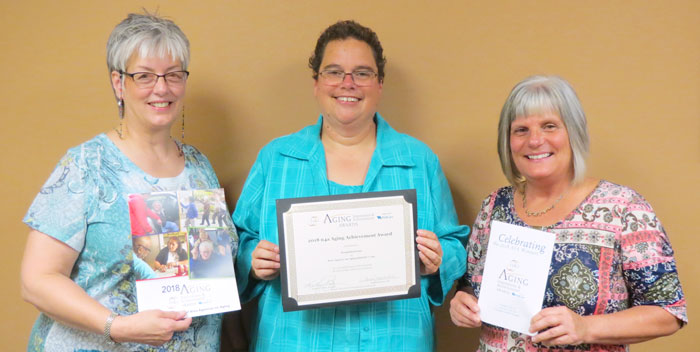Hospital2Home
- Need: To prevent hospital readmissions and improve the recovery process for older adults in rural southern Ohio.
- Intervention: Hospital2Home identifies individuals who have an elevated risk of hospital readmission and provides vouchers for services like personal care and home-delivered meals.
- Results: In each of the seven years the program has been in operation, over 85% of participants have avoided readmission in the first two months after hospital discharge.
Description
In the rural southern region of Ohio, there are few personal care resources and limited transportation options for older adults after they have been discharged from a hospital. Limited social contacts and fewer available caregivers also contribute to an elevated risk of hospital readmission.

In 2017, the Area Agency on Aging District 7, Inc. (AAA7) began the Hospital2Home program to help older adults in this 10-county region transition from the hospital to their homes. This program gives eligible patients vouchers for services like personal care (assisting with activities like bathing and getting dressed) and home-delivered meals. As of 2024, 18 personal care service providers, seven home-delivered meal providers, and seven hospitals participate in the program.
Prior to Hospital2Home, AAA7 operated a case management program which offered ongoing personal care and home-delivered meals with Senior Community Services State Block grant funds. Unfortunately, this program had only one case manager assigned to a large service area, which created long waitlists for services. Through the use of vouchers and referrals, Hospital2Home is able to use this same funding source to reach the same population without a waitlist.
Services offered
Hospital discharge planners and/or social workers identify recently admitted patients age 60 or older who are not currently on Medicaid and who have an elevated risk of hospital readmission. Risk factors include:
- Living alone
- Having limited access to or no caregivers
- Being 75 years or older
- Taking 6+ medications
- Living with more than one chronic condition
- Having stayed in the hospital multiple times
The program offers redeemable service vouchers for home-delivered meals and personal care. Patients eligible for home-delivered meals are those who are unable to prepare their own meals and/or don't have a caregiver who prepares their meals. Patients eligible for personal care are those who need assistance with at least two activities of daily living (ADLs) such as bathing, getting dressed, and eating.
In addition, patients can speak with an AAA7 options counselor about long-term care services and supports. The options counselor also helps patients understand their medications and discharge instructions and teaches them how to access any needed transportation and medical care. This counselor stays in touch with the patient for up to three months after hospital discharge.
Results
In the program's first year, Hospital2Home served twice as many patients as the previous case management program and used 27% less funding. In 2020 and 2021, fewer participants were served, related to the pandemic and decreased hospital stays for routine or scheduled procedures. However, many participants who were discharged after being hospitalized for COVID-19 were served by the program, initially through the home-delivered meals and later - as homecare agencies developed COVID guidelines - through personal care services. Beginning in April 2022, more normal operations have resumed in the rural area. In each of the seven years the program has been in operation, between 85-90% of participants avoided readmission in the first two months after discharge.
In addition, the program has seen the following outcomes:
- 92% of participants rated services as excellent
- 93% rated the options counselor's service as excellent
- 85% reported that the options counselor educated them on available community resources
- 82% reported that the services helped their recovery process
- 58% reported that the services helped their caregivers
In July 2018, the program received an Aging Innovations and Achievement Award from the National Association of Area Agencies on Aging. Also in 2018, AAA7 awarded their annual Partnership Award to the local hospitals and providers who assisted with the Hospital2Home program.

Challenges
One initial challenge was developing a system for confidential information exchange between AAA7 and hospital staff, along with a shared understanding of program eligibility. Additionally, contracting with service providers required educating them on how they could benefit from providing such short-term services.
A statewide direct care workforce shortage continues to affect service availability in some counties in the AAA7 service area. One strategy for overcoming this issue has been to increase rates for service providers. It is not clear at this time if this strategy alone will increase provider availability and retention.
Another challenge relates to high turnover at the local hospital, leading to a need to continually re-educate staff on the program.
Replication
Area Agencies on Aging as well as other social service agencies can reduce costs and more effectively serve older adults with this program model. Program coordinators offer the following advice to implement a successful program:
- Establish partnerships with the hospitals and provider agencies during the planning process.
- Develop a system to measure your results.
- Hire experienced staff: The options counselor providing resource information and problem-solving after hospital discharge is essential to the success of the program.
- Program referrals will continue to grow in rural areas with few resources and by word of mouth. After a few years, Hospital2Home became a "standard service" offered by many area hospitals.
Contact Information
Teresa Reed-Powell, BSW, MSW, LSW, Director of Community ServicesArea Agency on Aging District 7, Inc.
800.582.7277, Ext. 23-363
H2H@aaa7.org
Topics
Aging and aging-related services
· Elderly population
· Home and community-based services
States served
Ohio
Date added
May 21, 2018
Suggested citation: Rural Health Information Hub, 2024 . Hospital2Home [online]. Rural Health Information Hub. Available at: https://www.ruralhealthinfo.org/project-examples/1010 [Accessed 21 December 2025]
Please contact the models and innovations contact directly for the most complete and current information about this program. Summaries of models and innovations are provided by RHIhub for your convenience. The programs described are not endorsed by RHIhub or by the Federal Office of Rural Health Policy. Each rural community should consider whether a particular project or approach is a good match for their community’s needs and capacity. While it is sometimes possible to adapt program components to match your resources, keep in mind that changes to the program design may impact results.
